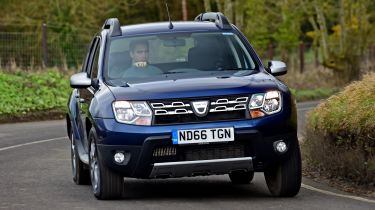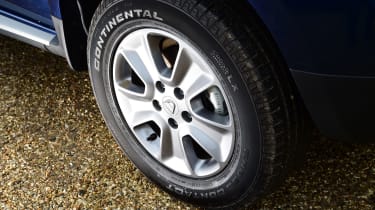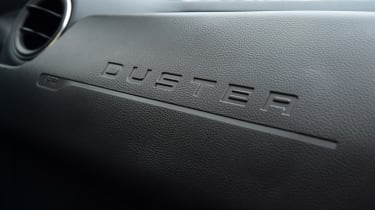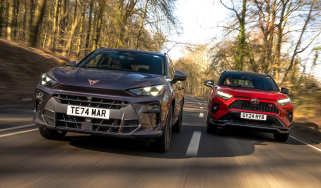Dacia Duster (2009-2017) review - Interior, design and technology
The Duster isn’t the most stylish or high-tech machine inside, but space and practicality more than compensate

There have been a few subtle revisions to the Duster in 2016. Look closely, and you might notice the squarer, multi-part headlights. Together with the chrome grille, satin silver skid plates and relatively high ride height, these minor changes give the car a more rugged look. There are satin silver side sills and Duster-branded roof bars to go with the skid plates.
The no-frills models further down the range get black plastic bumpers and steel wheels. But Laureate and Prestige models get colour coded bumpers, although there’s still some black plastic in evidence. It gives the car a bit less of a utilitarian look, and combined with 16-inch alloy wheels and some of the more extravagant paint colour, it balances the Duster’s straightforward shape with a little bit of style.
The Duster's wide wheelarches give the car plenty of presence on the road, but while it might look as substantial as some rivals, it doesn’t feel that way. Pull the plasticky door handles and open the lightweight doors, and you’re met by a sea of solid surfaces.
The appealing style isn’t quite carried through to the inside. As part of the facelift there was new upholstery for the seats, while the dash finish and satin chrome inserts that flank the centre console and feature on the steering wheel are also added. Despite the updates, material quality still feels decidedly budget level.
Used - available now

2022 Dacia
Duster
30,755 milesManualDiesel1.5L
Cash £13,400
2023 Dacia
Duster
15,733 milesAutomaticPetrol1.3L
Cash £16,963
2017 Dacia
Duster
49,163 milesManualDiesel1.5L
Cash £8,500
2020 Dacia
Duster
60,148 milesManualPetrol1.3L
Cash £9,906Apart from a few flashes of brightness, including the chrome rings around the dials, it’s a dull cabin. The dashboard is neat enough, but a bit plain compared to other compact SUVs – and quality reflects its budget roots in being a bit plasticky and plain in places. It feels like a supermini-class car, rather than a more premium SUV.
The dials and switchgear will be familiar to Renault Clio drivers, and it’s all very simple to use. It lacks high-tech features, preferring good old fashioned knobs to more modern electronic displays. You don’t even get a trip computer or until the top-spec Laureate, for example.
The only version that does feature advanced tech is the Prestige: it comes with a standard MediaNav Evolution touchscreen infotainment system with sat-nav. This has live traffic info and Aha web radio; the regular Laureate is available with an older version of MediaNav sat-nav as an option. At least you get a DAB radio and Bluetooth as standard, while cruise control is also included. The nav is around £450, while adding a reversing camera costs around £400. If you also choose rear parking sensors, they’ll cost another £200.
Cloth trim in Ambience models feels cheap, but things do improve as you go up the range (every variant has a different type of seat trim). You can also choose leather on all versions above Ambience, but we’d stick with cloth.
Sat-nav, stereo and infotainment
It’s a huge black mark here for the Access – because you don’t even get a radio as standard! At least Dacia fits the pre-wiring for an aftermarket stereo and speakers.
Ambience models have an MP3-compatible CD stereo with AUX and USB connectivity, plus remote fingertip controls and Bluetooth connectivity. If you want infotainment, you must choose the optional MediaNav kit on the Laureate (it costs a bargain £300), or take the Prestige where it’s fitted as standard.









